The Brazos Review: AMD's E-350 Supplants ION for mini-ITX
by Anand Lal Shimpi on January 27, 2011 6:08 PM ESTHeavy Lifting: Performance in Complex Workloads
Brazos is clearly faster than Atom in light workloads, but what about in more complex/heavier applications? Are the Bobcat cores enough to allow E-350 systems to move up in the world or will they still be confined to the web browsing/email usage models of netbooks? I've run the E-350 through our entire Bench suite to find out. If you want the full gamut of results head over to CPU Bench, but I've chosen a few here. I also included performance results from a 2.66GHz Pentium 4 to put things in perspective for users of really old systems.
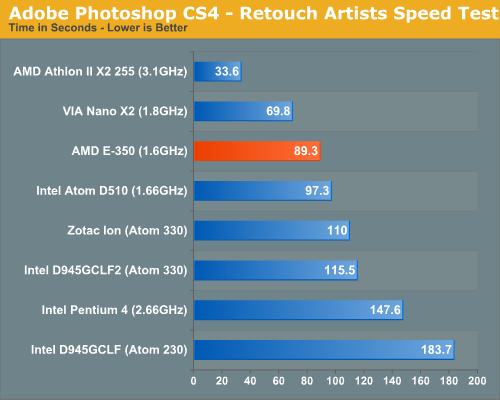
Photoshop CS4 performance is not half bad on the E-350 compared to other similarly priced platforms. Also impressive is the E-350's performance advantage over the old Pentium 4. Compared to the Athlon II X2 however the E-350 is still noticeably slower.
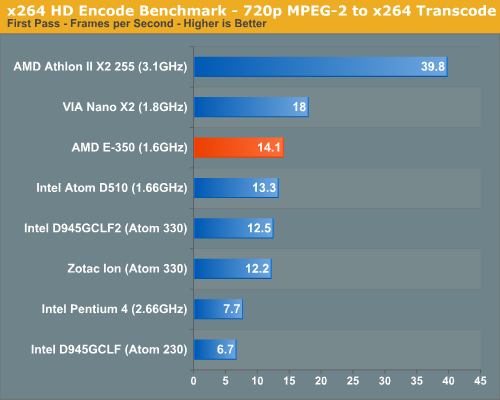
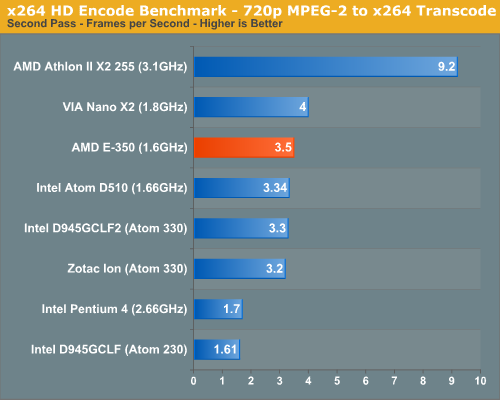
The standings and performance trends continue in our x264 encode benchmark. I don't expect you to do a lot of video transcoding on the E-350 as it's not much faster than Atom here. VIA's dual-core Nano is a bit quicker but still not enough to make this a viable usage case.
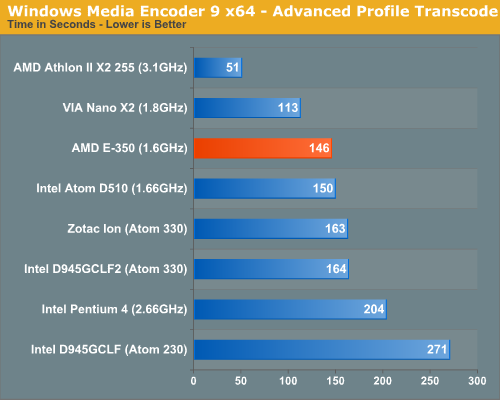
Windows Media Encoder provides a far lighter workload, but the standings don't change. The E-350 is faster than anything Atom based, faster than the old Pentium 4, but slower than VIA's Nano X2.
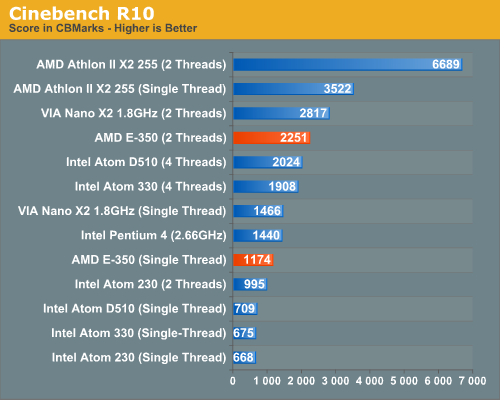
While I don't expect E-350 users to do any offline 3D rendering work, Cinebench does give us a good characterization of single threaded performance. The problem with Atom is that its single threaded performance isn't nearly as good as its multithreaded performance. In all of the previous benchmarks an Atom D510 is clearly quicker than the old 2.66GHz Pentium 4, but looking at single threaded Cinebench R10 you get a different story entirely. The P4 has nearly twice the single threaded performance of an Atom D510.
The E-350 is still a bit behind the Pentium 4 in single threaded performance, but it's not nearly as bad as Atom. The out-of-order execution engine helps tremendously here. What you get as a result is a system that doesn't really feel slower than a 5 year old PC but has the features of a more modern system.
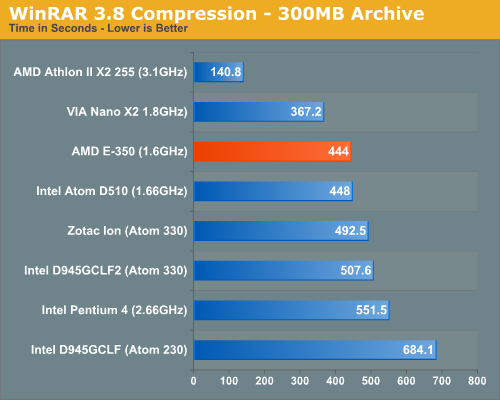
Overall the E-350 is clearly faster than Atom ever was at running these heavier workloads. The highly threaded workloads aren't much faster on E-350 vs. Atom thanks to the latter's Hyper Threading , but single threaded performance continues to play an important role and is a huge advantage of AMD's. VIA's simple out-of-order architecture is consistently faster than the E-350, however I don't expect to see widespread adoption or support for VIA's platform (at least compared to AMD's). Compared to the larger out-of-order x86 cores the E-350 is still in a lower performance class, the Athlon II X2 is easily twice as fast as the E-350 in these tests.
Ultimately the same rules that applied to Atom based systems apply to Brazos systems:
1) Swapping to disk is painful so you need enough memory (I'd recommend no less than 2GB for Windows 7, ideally 4GB) and you'll want a fast HDD. My preference is still an SSD, even a low end value drive over even a fast hard drive. Even a low end SSD (e.g. Kingston SSDNow V100) will make a Brazos system feel acceptably fast.
2) Outside of media playback and some gaming, you're still limited in the types of applications and workloads you can run on Brazos. The Brazos platform is great for web browsing/email workloads, but don't try to do too much more with it. The advantage over Atom here is that Brazos just does those things noticeably faster.










176 Comments
View All Comments
7Enigma - Friday, January 28, 2011 - link
Last line of the second page:"ASUS is working on a passively cooled E-350 motherboard which I should have within the next week."
silverblue - Friday, January 28, 2011 - link
Aha! I KNEW it!I knew somebody would replace the fan in no time at all... :) And losing that fan's power is even better for a system that doesn't drink too much in the first place.
nitrousoxide - Friday, January 28, 2011 - link
A fanless HTPC with decent performance...that's what people are expecting for years :)However I doubt if it is entirely silent as you still have to use case fans and noisy HDDs :)
silverblue - Friday, January 28, 2011 - link
If it's no louder than my Dreamcast, I can certainly live with that. :Pcybersax2 - Friday, January 28, 2011 - link
Nice review!I'm a bit surprised that the E350 isn't compared to an Atom D525 + ION2 combo (like the ZOTAC ZBOX ID41 uses).
silverblue - Friday, January 28, 2011 - link
He trolls every AMD launch article on here and Toms. Don't worry; unless he decides to actually contribute, he won't be at either place for long.ash9 - Friday, January 28, 2011 - link
Would be interesting to run a few optimized programs (OpenCL) and benchmark the differences. Hidden value - can it get any better?asH
haplo602 - Friday, January 28, 2011 - link
Hi AnandSeems nobody does answer the following questions:
1. Is the iGPU disabled automaticaly when a discreete one is plugged in ?
2. If not, does the system support Hybrid CF (or will it ) ?
3. Can the iGPU be used as a GPGPU device when a discreet GPU is plugged in and/or the iGPU is not driving a display ?
thanks ...
sebanab - Monday, January 31, 2011 - link
In my opinion the hole discrete GPU side of Zacate should be ignored completely.At the moment it does not bing any considerable advantages to add a discrete GPU, and if it will very few people would consider doing it.
But these questions will nonetheless be very interesting in the Llano review!
silverblue - Monday, January 31, 2011 - link
You definitely have a point. In most tests, it really doesn't look as if adding a discrete card would make any real difference, be it a 5570 or a 5870. The Bobcat cores don't look to be capable of handling enough data so perhaps the 6310 was the sweet spot for performance without the whole thing being too CPU-limited.Now if they added two more cores, perhaps we'd see a better GPU on-die, but the situation could still be the same. Then there's the matter of the 4x port.
I suspect the same will go for Llano; AMD knows that Phenom and Athlon II are CPU limited until the highest resolutions for most modern titles so there's little point giving them an overpowered GPU that is underfed. Putting a GPU on Bulldozer could be too expensive for the moment, but it's unlikely that Bulldozer would have issues feeding a relatively powerful graphics card.